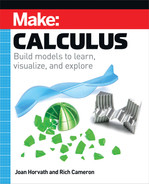When Isaac Newton developed calculus in the 1600s, he was trying to tie together math and physics in an intuitive, geometrical way. But over time math and physics teaching became heavily weighted toward algebra, and less toward geometrical problem solving. However, many practicing mathematicians and physicists will get their intuition geometrically first and do the algebra later. Make:Calculus imagines how Newton might have used 3D printed models, construction toys, programming, craft materials, and an Arduino or two to teach calculus concepts in an intuitive way. The book uses as little reliance on algebra as possible while still retaining enough to allow comparison with a traditional curriculum. This book is not a traditional Calculus I textbook. Rather, it will take the reader on a tour of key concepts in calculus that lend themselves to hands-on projects. This book also defines terms and common symbols for them so that self-learners can learn more on their own.
Table of Contents
- Cover
- Title Page
- Copyright Page
- Contents
- Dedication
- Preface
- Chapter 1: The Fundamental Theorem
- Chapter 2: Calculus and its Limits
- Chapter 3: 3D Printed Models
- Chapter 4: Derivatives: The Basics
- Chapter 5: Using and Calculating Derivatives
- Chapter 6: Integrals: the Basics
- Chapter 7: Integrals and Volume
- Chapter 8: Modeling Exponential Growth and Decay
- Chapter 9: Modeling Periodic Systems
- Chapter 10: Calculus, Circuits, and Code
- Chapter 11: Coordinate Systems and Vectors
- Chapter 12: Series
- Chapter 13: Your Toolbox
- Index
- Also from the authors:
